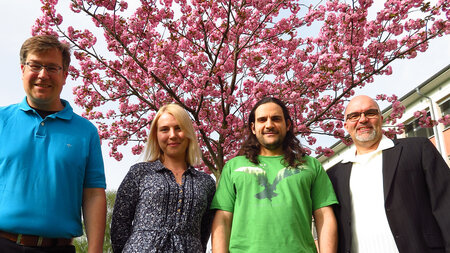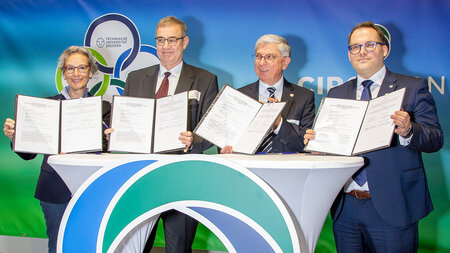Prof. Dr. Georg Jahn

-
Phone:+49 371 531-36338
-
Email:
-
Address:Wilhelm-Raabe-Straße 43, 09120 Chemnitz
-
Room:B01.112.1 (prev. 4/112A)
Research interests
- Hybrid Societies
- Cognitive Ergonomics
- Measurement of Mental Workload
- Skill Acquisition with Human-Machine-Interfaces
- Eye Tracking for Process Tracing (Memory Indexing)
- Multiple Object Tracking
- Diagnostic Reasoning
- Spatial Cognition
CV
- since 2016: Professorship for Applied Geropsychology and Cognition
- 2014 – 2016: Professorship for Engineering Psychology and Cognitive Ergonomics, University of Lübeck
- 2008 – 2014: Junior Professorship for Cognitive Psychology, University of Greifswald
- 2013: Habilitation (Venia legendi Psychology), Chemnitz University of Technology
- 2012: Deputy Professorship for Cognitive Psychology with pedagogical-psychological Application Focus, University of Paderborn
- 2005 – 2008: Research Associate at the Professorship for Cognitive and Engineering Psychology, Chemnitz University of Technology
- 2003 – 2005: Research Associate at the Transregional DFG Collaborative Research Centre „Spatial Cognition“ (DFG SFB/TR8) at the Department for Cognitive Science, University of Freiburg
- 2004 – 2005: Research Stay at Max Planck Institute for Biological Cybernetics, Tübingen
- 2003 – 2004: Research Stay at Department of Psychology, Princeton University
- 2001 – 2003: Research Associate (Project Management) in BASt-Project „Kompetenzerwerb im Umgang mit Fahrerassistenz- und -informationssystemen“ Chemnitz University of Technology
- 2001: Doctorate (Dr. phil.) in Psychology, University of Regensburg
- 1997 – 2001: Research Associate at the Professorship for General Psychology and Clinical Psychology, University of Regensburg
Publications
In Journals (peer-reviewed)
Jahn, G. (2024). Resilience engineering for highly automated driving, autonomous vehicles, and urban robotics: Wizards and shepherds in hybrid societies. Theoretical Issues in Ergonomics Science.
doi:10.1080/1463922X.2024.2328062
Kopiske, K., Heinrich, E.-M., Jahn, G., Bendixen, A., & Einhäuser, W. (2023). Multisensory cues for walking in virtual reality: humans combine conflicting visual and self-motion information to reproduce distances. Journal of Neurophysiology.
doi:10.1152/jn.00011.2023
Borodaeva, Z., Winkler, S., Brade, J., Klimant, P., & Jahn, G. (2023). Spatial updating in virtual reality for reproducing object locations in vista space: Boundaries, landmarks, and idiothetic cues. Frontiers in Psychology, 14:1144861. doi:10.3389/fpsyg.2023.1144861
Mandl, S., Brade, J., Bretschneider, M., Asbrock, F., Meyer, B., Jahn, G., Klimant, P., & Strobel, A. (2023). Perception of embodied digital technologies: robots and telepresence systems. Human-Intelligent Systems Integration. doi:10.1007/s42454-023-00049-x
Kuball, T., Pollmanns, C., Asbrock, F., & Jahn, G. (2023). Older adults’ stereotypes of and attitudes toward younger adults and intergenerational contact frequency. Journal of Intergenerational Relationships, 1-22. doi:10.1080/15350770.2023.2223196
Eisenträger, K., Haubner, J., Brade, J., Einhäuser, W., Bendixen, A., Winkler, S., Klimant, P., & Jahn, G. (2023). Evaluating the effects of virtual‐reality environment learning on subsequent robot teleoperation in an unfamiliar building. IEEE Transactions on Visualization and Computer Graphics, 29, 2220-2229. doi:10.1109/TVCG.2023.3247052
Henke, L., Guseva, M., Wagemans, K., Pischedda, D., Haynes, J.-D., Jahn, G., & Anders, S. (2022) Surgical face masks do not impair the decoding of facial expressions of negative affect more severely in older than in younger adults. Cognitive Research: Principles and Implications, 7:63, 1-15. doi:10.1186/s41235-022-00403-8
Kleissner, V., & Jahn, G. (2021). Implicit and explicit age cues influence the evaluation of job applications. Journal of Applied Social Psychology, 51(2), 107-120. doi:10.1111/jasp.12720
Schwind, N., & Jahn, G. (2021). Die Einstellung von Patienten in geriatrischer Rehabilitation zu Pflegeheimen. Zeitschrift für Gerontologie und Geriatrie, 54, 485-491. doi:10.1007/s00391-020-01773-8
Kleissner, V., & Jahn, G. (2020). Dimensions of work-related age stereotypes and in-group favoritism. Research on Aging, 42(3-4), 126-136. doi:10.1177/0164027519896189
Kleissner, V., & Jahn, G. (2020). Implicit and explicit measurement of work-related age attitudes and age stereotypes. Frontiers in Psychology, 11, 579155. doi:10.3389/fpsyg.2020.579155
Frankenstein, L. L., & Jahn, G. (2020). Behavioral and occupational therapy for dementia patients and caregivers. GeroPsych, 33, 85-100. doi:10.1024/1662-9647/a000225
Berneiser, J., Jahn, G., Grothe, M., & Lotze, M. (2018). From visual to motor strategies: Training in mental rotation of hands. Neuroimage, 167, 247-255. doi:10.1016/j.neuroimage.2016.06.014
Scholz, A., Krems, J. F., & Jahn, G. (2017). Watching diagnoses develop: Eye movements reveal symptom processing during diagnostic reasoning. Psychonomic Bulletin & Review, 24, 1398-1412. doi:10.3758/s13423-017-1294-8
Papenmeier, F., Meyerhoff, H. S., Brockhoff, A., Jahn, G., & Huff, M. (2017). Upside-down: Perceived space affects object-based attention. Journal of Experimental Psychology: Human Perception and Performance, 43, 1269-1274. doi:10.1037/xhp0000421
Rebitschek, F., Krems, J. F., & Jahn, G. (2016). The diversity effect in diagnostic reasoning. Memory & Cognition, 44, 789-805. doi:10.3758/s13421-016-0592-0
Meyerhoff. H. S., Papenmeier, F., Jahn, G., & Huff, M. (2016). Not FLEXible enough: Exploring the temporal dynamics of attentional reallocations with the multiple object tracking paradigm. Journal of Experimental Psychology: Human Perception and Performance, 42, 776-787. doi:10.1037/xhp0000187
Brockhoff, A., Papenmeier, F., Wolf, K., Pfeiffer, T., Jahn, G., & Huff, M. (2016). Viewpoint matters: Exploring the involvement of reference frames in multiple object tracking from a developmental perspective. Cognitive Development, 37, 1-8. doi:10.1016/j.cogdev.2015.10.004
Krüger, M., & Jahn, G. (2015). Children’s spatial representations: 3- and 4-year-olds are affected by irrelevant peripheral references. Frontiers in Psychology, 6:1677. doi:10.3389/fpsyg.2015.01677
Rebitschek, F., Bocklisch, F., Scholz, A., Krems, J. F., & Jahn, G. (2015). Biased processing of ambiguous symptoms favors the initially leading hypothesis in sequential diagnostic reasoning. Experimental Psychology, 62, 287-305. doi:10.1027/1618-3169/a000298
Rebitschek, F., Krems, J. F., & Jahn, G. (2015). Memory activation of multiple hypotheses in sequential diagnostic reasoning. Journal of Cognitive Psychology, 27, 780-796. doi:10.1080/20445911.2015.1026825
Meyerhoff. H. S., Papenmeier, F., Jahn, G., & Huff, M (2015). Distractor locations influence multiple object tracking beyond interobject spacing: Evidence from equidistant distractor displacements. Experimental Psychology, 62, 170-180. doi:10.1027/1618-3169/a000283
Jahn, G., & Braatz, J. (2014). Memory indexing of sequential symptom processing in diagnostic reasoning. Cognitive Psychology, 68, 59-97. doi:10.1016/j.cogpsych.2013.11.002
Papenmeier, F., Meyerhoff, H. S., Jahn, G., & Huff, M. (2014). Tracking by location and features: Object correspondence across spatiotemporal discontinuities during multiple object tracking. Journal of Experimental Psychology: Human Perception and Performance, 40(1), 159-171. doi:10.1037/a0033117
Jahn, G., & Krems, J. F. (2013). Skill acquisition with text-entry interfaces: Particularly older users benefit from minimized information-processing demands. Journal of Applied Gerontology, 32, 605-626. doi:10.1177/0733464811433485
Meyerhoff, H. S., Papenmeier, F., Jahn, G., & Huff, M. (2013). A single unexpected change in target- but not distractor motion impairs multiple object tracking. i-Perception, 4(1), 81-83. doi:10.1068/i0567sas
Pau, S., Jahn, G., Sakreida, K., Domin, M., & Lotze, M. (2013). Encoding and recall of finger sequences in experienced pianists compared with musically naive controls: A combined behavioral and functional imaging study. NeuroImage, 64, 379-387. doi:10.1016/j.neuroimage.2012.09.012
Renkewitz, F., & Jahn, G. (2012). Memory Indexing: A novel method for tracing memory processes in complex cognitive tasks. Journal of Experimental Psychology: Learning, Memory, and Cognition, 38, 1622-1639. doi:10.1037/a0028073
Schaer, K., Jahn, G., & Lotze, M. (2012). fMRI-activation during drawing a naturalistic or sketchy portrait. Behavioural Brain Research, 233, 209-216. doi:10.1016/j.bbr.2012.05.009
Jahn, G., Wendt, J., Lotze, M., Papenmeier, F., & Huff, M. (2012). Brain activation during spatial updating and attentive tracking of moving targets. Brain and Cognition, 78, 105-113. doi:10.1016/j.bandc.2011.12.001
Jahn, G., Papenmeier, F., Meyerhoff, H. S., & Huff, M. (2012). Spatial reference in multiple object tracking. Experimental Psychology, 59, 163-173. doi:10.1027/1618-3169/a000139
Meyerhoff, H. S., Huff, M., Papenmeier, F., Jahn, G., & Schwan, S. (2011). Continuous visual cues trigger automatic spatial target updating in dynamic scenes. Cognition, 121, 73-82. doi:10.1016/j.cognition.2011.06.001
Huff, M., Papenmeier, F., Jahn, G., & Hesse, F. W. (2010). Eye movements across viewpoint changes in multiple object tracking. Visual Cognition, 18, 1368-1391. doi:10.1080/13506285.2010.495878
Huff, M., Meyerhoff, H. S., Papenmeier, F., & Jahn, G. (2010). Spatial updating of dynamic scenes: Tracking multiple invisible objects across viewpoint changes. Attention, Perception, & Psychophysics, 72, 628-636. doi:10.3758/APP.72.3.628
Jahn, G., Krems, J. F., & Gelau, C. (2009). Skill acquisition while interacting with in-vehicle information systems: Interface design determines the level of safety-relevant distractions. Human Factors, 51, 136-151. doi:10.1177/0018720809336542
Huff, M., Jahn, G., & Schwan, S. (2009). Tracking multiple objects across abrupt viewpoint changes. Visual Cognition, 17, 297-306. doi:10.1080/13506280802061838
Jahn, G., Knauff, M., & Johnson-Laird, P. N. (2007). Preferred mental models in reasoning about spatial relations. Memory & Cognition, 35, 2075-2087. doi:10.3758/BF03192939
Jahn, G., Oehme, A., Krems, J. F., & Gelau, C. (2005). Peripheral detection as a workload measure in driving: Effects of traffic complexity and route guidance system use in a driving study. Transportation Research Part F: Traffic Psychology and Behaviour, 8, 255-275. doi:10.1016/j.trf.2005.04.009
Jahn, G. (2004). Three turtles in danger: Spontaneous construction of causally relevant spatial situation models. Journal of Experimental Psychology: Learning, Memory, and Cognition, 30, 969-987. doi:10.1037/0278-7393.30.5.969
In Proceedings (peer-reviewed)
Siebert, N., Wenner, H., Kuball, T., Kiel, F., Beggiato, M., Oer, S., & Jahn, G. (2023). Digital support requirements for the care community QuartierPflege. In J. Kalra (Ed.), Human Factors in Aging and Special Needs. AHFE (2023) International Conference. AHFE Open Access, Vol. 88 (pp. 85-94). USA: AHFE International. doi:10.54941/ahfe1003665
Brade, J., Hoppe, T., Winkler, S., Jahn, G. & Klimant, P. (2023) Visual cues improve spatial orientation in telepresence as in VR. In T. Ahram, W. Karwowski, P. Di Bucchianico, R. Taiar, L. Casarotto, & P. Costa (Eds), Intelligent Human Systems Integration (IHSI 2023): Integrating People and Intelligent Systems. AHFE (2023) International Conference. AHFE Open Access, Vol. 69 (pp. 428-434). AHFE International. doi:10.54941/ahfe1002862
Mandl, S., Brade, J., Bretschneider, M., Skripcak, A., Asbrock, F., Meyer, B., Jahn, G., Klimant, P., & Strobel, A. (2023) Social perception of Embodied Digital Technologies interacting with humans. In T. Ahram, W. Karwowski, P. Di Bucchianico, R. Taiar, L. Casarotto, & P. Costa (Eds), Intelligent Human Systems Integration (IHSI 2023): Integrating People and Intelligent Systems. AHFE (2023) International Conference. AHFE Open Access, Vol. 69 (pp. 186-196). AHFE International. doi:10.54941/ahfe1002836
Brade, J., Winkler, S., Beisig, L. S., Flucke, J., Jasniewcz, L., Laaser, J., Seehars, A., Jahn, G., & Klimant, P. (2022). How far is it? Distance estimation and reproduction through a Double 3 telepresence robot. 2022 IEEE International Symposium on Mixed and Augmented Realoity Adjunct (ISMAR-Adjunct) (pp. 718-719). IEEE. doi:10.1109/ISMAR-Adjunct57072.2022.00151
Winkler, S., Weidensager, N., Brade, J., Knopp, S., Jahn, G., & Klimant, P. (2022). Use of an automated guided vehicle as a telepresence system with measurement support. 2022 IEEE 9th International Conference on Computational Intelligence and Virtusl Environments for Measurement Systems and Applications (CIVEMSA) (pp. 1-6). IEEE. doi:10.1109/CIVEMSA53371.2022.9853678
Schuler, K., Quante, L., Schießl, C., Beggiato, M., & Jahn, G. (2022). Communication between drivers in a road bottleneck scenario. In K. Plant & G. Praetorius (Eds.), Human Factors in Transportation. AHFE (2022) International Conference. AHFE Open Access, Vol. 60 (pp. 306-312). AHFE International. https://doi.org/10.54941/ahfe1002461
Breitkreutz, C., Brade, J., Winkler, S., Bendixen, A., Klimant, P., & Jahn, G. (2022). Spatial updating in virtual reality: Auditory and visual cues in a cave automatic virtual environment. In 2022 IEEE Conference on Virtual Reality and 3D User Interfaces (pp. 719-727). IEEE. https://doi.org/10.1109/VR51125.2022.00093
Jahn, G., Dudczig, M., & Klimant, P. (2019). Spatial updating based on visually signaled self-motion in virtual reality. In In A.K. Goel, C.M. Seifert, & C. Freksa (Eds.), Proceedings of the 41st Annual Conference of the Cognitive Science Society (p. 3288). Montreal, QB: Cognitive Science Society. https://mindmodeling.org/cogsci2019/papers/0596/index.html
Kupffer, R., Wutzler, M., Krems, J. F., & Jahn, G. (2018). A comparison of a smartphone app and a wrist-worn fitness tracker for self-monitoring of physical activity by older and younger users. In B. Guidi, L. Ricci, C. Calafate, O. Gaggi, & J. Marquez-Barja (Eds.), Smart Objects and Technologies for Social Good. GOODTECHS 2017. Lecture Notes of the Institute for Computer Sciences, Social Informatics and Telecommunications Engineering, Vol. 233 (pp. 331-341). Cham: Springer. doi:10.1007/978-3-319-76111-4_33
Jahn, G., Stahnke, R., & Rebitschek, F. G. (2014). Parallel belief updating in sequential diagnostic reasoning. In P. Bello, M. Guarini, M. McShane, & B. Scassellati (Eds.), Proceedings of the Thirty-Sixth Annual Conference of the Cognitive Science Society (pp. 2405-2410). Austin, TX: Cognitive Science Society.
Rebitschek, F. G., Krems, J. F., & Jahn, G. (2014). A structure-dependent causal diversity effect in diagnostic reasoning. In P. Bello, M. Guarini, M. McShane, & B. Scassellati (Eds.), Proceedings of the Thirty-Sixth Annual Conference of the Cognitive Science Society (pp. 2829-2834). Austin, TX: Cognitive Science Society.
Jahn, G., & Braatz, J. (2012). Memory indexing of sequential symptom processing in diagnostic reasoning. In N. Miyake, D. Peebles, & R. P. Cooper (Eds.), Proceedings of the Thirty-Fourth Annual Conference of the Cognitive Science Society (pp. 497-502). Austin, TX: Cognitive Science Society.
Rebitschek, F. G., Scholz, A., Bocklisch, F., Krems, J. F., & Jahn, G. (2012). Order effects in diagnostic reasoning with four candidate hypotheses. In N. Miyake, D. Peebles, & R. P. Cooper (Eds.), Proceedings of the Thirty-Fourth Annual Conference of the Cognitive Science Society (pp. 905-910). Austin, TX: Cognitive Science Society.
Jahn, G., Müller-Bardorff, M., & Coventry, K. (2011). Spatial reasoning within visible functional constraints. In L. Carlson, C. Hölscher, & T. Shipley (Eds.), Proceedings of the Thirty-Third Annual Conference of the Cognitive Science Society (pp. 1539-1544). Austin, TX: Cognitive Science Society.
Renkewitz, F., & Jahn, G. (2010). Looking at nothing indicates memory search in multiattribute decision making. In S. Ohlsson, & R. Catrambone (Eds.), Proceedings of the Thirty-Second Annual Conference of the Cognitive Science Society (pp. 260-265). Austin, TX: Cognitive Science Society.
Renkewitz, F., & Jahn, G. (2010). Tracking memory search for cue information. In A. Glöckner & C. Witteman (Eds.), Foundations for Tracing Intuition: Challenges and Methods (pp. 199-218). Hove, UK: Psychology Press.
Mehlhorn, K., & Jahn, G. (2009). Modeling sequential information integration with parallel constraint satisfaction. In N. A. Taatgen, & H. van Rijn (Eds.), Proceedings of the Thirty-First Annual Conference of the Cognitive Science Society (pp. 2469-2474). Austin, TX: Cognitive Science Society.
Jahn, G., Renkewitz, F., & Kunze, S. (2007). Heuristics in multi-attribute decision making: Effects of representation format. In D. S. McNamara, & G. Trafton (Eds.), Proceedings of the Twenty-Ninth Annual Conference of the Cognitive Science Society (pp. 383-388). Mahwah, NJ: Erlbaum.
Jahn, G., Knauff, M., & Johnson-Laird, P. N. (2005). Preferred mental models in spatial reasoning. In B. G. Bara, L. W. Barsalou, & M. Bucciarelli (Eds.), Proceedings of the Twenty-Seventh Annual Conference of the Cognitive Science Society (pp. 1036-1041). Mahwah, NJ: Erlbaum.
Jahn, G., Johnson-Laird, P. N., & Knauff, M. (2004). Reasoning about consistency with spatial mental models: Hidden and obvious indeterminacy in spatial descriptions. In: C. Freksa, M. Knauff, B. Krieg-Brückner, B. Nebel, & T. Barkowsky (Eds.), Spatial Cognition IV - Reasoning, Action, Interaction. International Conference Spatial Cognition 2004, Frauenchiemsee, Germany, October 2004 (pp. 165-180). Berlin: Springer.
Jahn, G. (2003). Hybrid representation of spatial descriptions. In: F. Schmalhofer, R. M. Young, & G. Katz (Eds.), Proceedings of EuroCogSci03, The European Cognitive Science Conference 2003 (p. 401). Mahwah, NJ: Erlbaum.
Jahn, G., Keinath, A., Gelau, C., & Krems, J.F. (2003). Destination entry while driving: The benefit of constrained options to act in multitask situations illustrated by two route guidance systems. In: C. Stephanidis, & J. Jacko (Eds.), Human-Computer Interaction: Theory and Practice, Part II (pp. 93-97). Mahwah, NJ: Erlbaum.
Jahn, G., Krems, J.F. & Gelau, C. (2002). Skill-development when interacting with in-vehicle information systems: A training study on the learnability of different MMI concepts. In: D. de Waard, K. A. Brookhuis, J. Mooral, & A. Toffetti (Eds.), Human Factors in Transportation, Communication, Health, and the Workplace (pp. 35-48). Maastricht, NL: Shaker Publishing.
Other Publications
Frankenstein, L. L., & Jahn, G. (2021). Nichtmedikamentöse Therapie der Demenz: Mit Ergotherapie Alltagskompetenz erhalten. doctors|today, 1(5), 16-19. https://www.doctors.today/a/nichtmedikamentoese-therapie-der-demenz-mit-ergotherapie-alltagskompetenz-erhalten-2307724
Jahn, G., & Klimant, P. (2019). Mensch-Technik-Interaktion in hybriden Gesellschaften. In M. Putz, P. Klimant, & F. Klimant (Eds.), VAR2 2019 - Realität erweitern (pp. 109-117). Chemnitz: Technische Universität Chemnitz.
Jahn, G. (2019). "Nach Ihnen": Verkörperte digitale Technologien in Hybridgesellschaften der Zukunft. In E. Fricke & J. Bressem (Eds.), Gesten - gestern, heute, übermorgen (pp. 218-222). Chemnitz: Universitätsverlag Chemnitz.
Jahn, G., & Henning, M. (2007). Two new textbooks on applied cognitive psychology. Applied Cognitive Psychology, 21, 551-553. doi:10.1002/acp.1277
Krems, J., Jahn, G., Baumann, M., Rösler, D., & Mogilka, A. (2005). Fahren oder gefahren werden? Möglichkeiten und Grenzen von Telematiksystemen. In K. Karrer, B. Gauss, & Chr. Steffens (Hrsg.), Beiträge zur Mensch-Maschine-Systemtechnik aus Forschung und Praxis (pp. 79-91). Düsseldorf: Symposion.
Jahn, G., & Webber, L. (2005). Aligning with a ghost: Perspective, belief, and function in spatial reasoning. Proceedings of the Fifth Workshop on Language and Space. Delmenhorst, Germany.
Jahn, G., Oehme, A., Rösler, D., & Krems, J. F. (2004). Kompetenzerwerb im Umgang mit Fahrerinformationssystemen. Berichte der Bundesanstalt für Straßenwesen, F 47. Bremerhaven: Wirtschaftsverlag NW.
Krems, J., Jahn, G., & Baumann, M. (2004). Wer fährt? Zu den Möglichkeiten und Grenzen von Fahrerassistenz- und Fahrerinformationssystemen. In C. Zanger, S. Habscheid, & H. Gaus (Hrsg.), Bleibt das Auto mobil? Mobilität und Automobil im interdisziplinären Diskurs (pp. 195-207). Frankfurt: Peter Lang.
Krems, J., Keinath, A., Baumann, M. & Jahn, G. (2004). Die Okklusionsmethode: Ein einfaches und valides Verfahren zur Bewertung der visuellen Beanspruchung von Zweitaufgaben? In B. Schlag (Hrsg.). Verkehrspsychologie (S. 335-339). Lengerich: Pabst.
Rösler, D., Oehme, A., Jahn, G., Baumann, M., & Krems, J. (2004). Empirische Methoden zur Erfassung der Fahrerbeanspruchung. In C. Steffens, M. Thüring, & L. Urbas (Hrsg.), Entwerfen und Gestalten. 5. Berliner Werkstatt Mensch-Maschine-Systeme (S. 307-321). Düsseldorf: VDI Verlag.
Jahn, G., Krems, J. F., & Gelau, C. (2003). Exploring skill acquisition at the performance of an in-vehicle HMI task: Influences of situational demands and HMI design. In Proceedings of the XVth Triennial Congress of the International Ergonomics Association “Ergonomics in the Digital Age”, Vol. 3, Product Design (pp. 161-164). Seoul: Ergonomics Society of Korea.
Jahn, G., & Knauff, M. (2003). Raum zum Lesen: Die Konstruktion mentaler Modelle beim Verstehen narrativer Texte. In: T. Krämer-Badoni, & K. Kuhm (Hrsg.), Die Gesellschaft und ihr Raum (pp. 53-72). Leverkusen: Leske & Budrich.
Jahn, G., Krems, J.F., & Gelau, C. (2003). The 0.1 Hz component of heart rate variability (HRV) and the peripheral detection task (PDT) to measure driver workload. Journal of Psychophysiology 17(3), 156.
Baumann, M., Rösler, D., Jahn, G., & Krems, J.F. (2003). Assessing driver distraction using occlusion method and peripheral detection task. In H. Strasser, K. Kluth, H. Rausch, & H. Bubb (Eds.), Quality of Work and Products in Enterprises of the Future (pp. 53-56). Stuttgart: Ergonomia Verlag.
Gelau, C., Jahn, G., Krems, J.F., Uno, H., Kircher, A., Östlund, J., & Nilsson, L. (2003). State-of-the-art of the SNRA/JARI/BAST joint research on driver workload measurement within the framework of IHRA-ITS. Proceedings of the Eighteenth International Technical Conference on the Enhanced Safety of Vehicles (paper 242, 1-9).
Group Publications
Open Science Collaboration. (2015). Estimating the reproducibility of psychological science. Science, 349(6251). doi:10.1126/science.aac4716
Open Science Collaboration (2014). The Reproducibility Project: A model of large-scale collaboration for empirical research on reproducibility. In V. Stodden, F. Leisch, & R. Peng (Eds.), Implementing Reproducible Computational Research (A Volume in The R Series) (pp. 299-323). New York, NY: Taylor & Francis.
Open Science Collaboration. (2012). An open, large-scale, collaborative effort to estimate the reproducibility of psychological science. Perspectives on Psychological Science, 7, 652-655. doi:10.1177/1745691612462588





